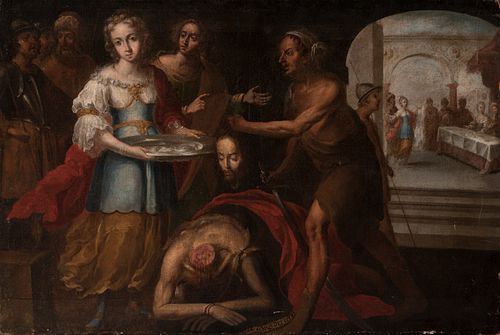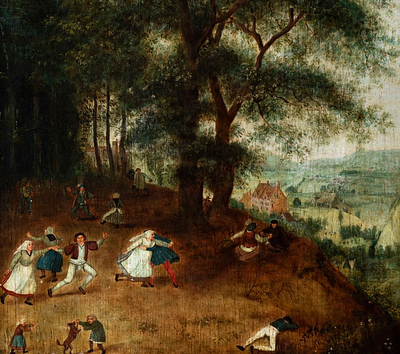Attributed to JUAN ESPINAL (Seville, 1714 - 1783). "Salome and the Baptist." Oil on canvas. Presents repaints.
Lot 86
About Seller
Setdart Auction House
Carrer Aragó 346
Barcelona
Spain
Setdart Subastas was born in 2004 and is currently the first online art auction in Spain with solidity, prestige and reliability guaranteed by our more than 60,000 users. Setdart has a young, dynamic and enterprising team ready to successfully manage the purchase and sale of art works through custom...Read more
Estimate:
EUR€5,000 - EUR€6,000
$5,376.34 - $6,451.61
Absentee vs Live bid
Two ways to bid:
- Leave a max absentee bid and the platform will bid on your behalf up to your maximum bid during the live auction.
- Bid live during the auction and your bids will be submitted real-time to the auctioneer.
Bid Increments
| Price | Bid Increment |
|---|---|
| EUR€0 | EUR€10 |
| EUR€200 | EUR€25 |
| EUR€500 | EUR€50 |
| EUR€1,000 | EUR€100 |
| EUR€3,000 | EUR€200 |
| EUR€5,000 | EUR€500 |
| EUR€10,000 | EUR€1,000 |
| EUR€20,000 | EUR€2,000 |
| EUR€50,000 | EUR€5,000 |
About Auction
By Setdart Auction House
Jun 30, 2021
Set Reminder
2021-06-30 08:30:00
2021-06-30 08:30:00
America/New_York
Bidsquare
Bidsquare : Old Masters
https://www.bidsquare.com/auctions/setdart-auction-house/old-masters-7134
Setdart Auction House sofia@setdart.com
Setdart Auction House sofia@setdart.com
- Lot Description
Attributed to JUAN ESPINAL (Seville, 1714 - 1783). "Salome and the Baptist." Oil on canvas. Presents repaints. Measures: 104 x 158 cm. Herodias, wife of Herod Philip, married in a scandalous way with his half-brother, Herod Antipas, which provoked a war, since Herod Antipas had repudiated his previous wife, daughter of the Nabataean monarch. The attitude of the new marriage was very criticized by the people, since it was considered sinful, and one of those who most denounced it was John the Baptist, for which he was arrested, although Herod did not dare to execute him for fear of the popular wrath. According to tradition, Salome, a woman of great beauty, danced for her stepfather, and he enthusiastically offered to grant her the prize she desired. Then the young woman asked, following her mother's instructions, for the Baptist's head, which was given to her "on a silver platter" This work stands out for its narrative unity, since the two most characteristic moments of the story can be appreciated. In the right zone, the moment in which Salome, dances at the banquet and in the center of the composition Salome with the head of St. John on the silver tray. The dramatism with which the body of the saint is presented to the spectator is outstanding. Juan de Espinal was able to overcome the then predominant Murillo spirit prevailing in local painting, opening himself to other tendencies coming from Europe, among which the Rococo style predominated. He possessed an elegant sense of chromatism, a light brushstroke and an agile and vibrant drawing, as we see in this San Miguel Arcángel. Among the attributions, we can mention the Immaculate Conception preserved in the Lázaro Galdiano Museum in Madrid and the tempera decoration of the vault of the Church of San Francisco de Utrera, on the theme Apotheosis of the Jesuit Order. He has also been attributed a series of thirteen paintings of circular format, now conserved in the Santa Casa de Loyola in Guipúzcoa, possibly copies of the series of Jesuit stories that the Flemish Jesuit Ignacio Raeth painted for the Novitiate of Madrid. Son of the painter Gregorio Espinal, Juan de Espinal must have received his first artistic teachings from his father. He apprenticed in the workshop of Domingo Martínez, where he probably met his master's daughter, Juana Martínez, whom he would later marry. In 1749, after the death of his father-in-law and master, he inherited his father's workshop and presumably his clientele, enjoying a prestigious position. Proof of this are the various commissions he received, both from the city council and the ecclesiastical hierarchy. Another of his facets was teaching, being one of the main promoters of the art school known as Real Escuela de las Tres Nobles Artes de Sevilla and director of the painting section of this school since 1775. His first work of which we have evidence is the tempera decoration of the vault of the Church of El Salvador (Seville). It is a representation of the heavenly Glory presided over by the Holy Spirit in the form of a dove. In 1759 he was commissioned by the City Council of Seville to paint a picture of Saints Justa and Rufina, a theme already treated by Murillo. The result was a splendid work in which Espinal introduced iconographic novelties in the representation of these saints. Other of his most brilliant works are the Alegoría de la pintura Sevillana, currently on display at the Real Academia de Bellas Artes de San Fernando (Madrid), and San Carlos Borromeo dando la comunión a los apestados de Milán (Church of San Nicolás de Bari in Seville). His best group of works is undoubtedly the series of fifteen paintings on religious themes commissioned by the Archbishop of Seville Don Francisco Javier Delgado y Venegas and currently housed in the Archbishop's Palace.
- Shipping Info
-
In-house shipping available. Please inquire at admin@setdart.com.
-
- Buyer's Premium



 EUR
EUR CAD
CAD AUD
AUD GBP
GBP MXN
MXN HKD
HKD CNY
CNY MYR
MYR SEK
SEK SGD
SGD CHF
CHF THB
THB
















